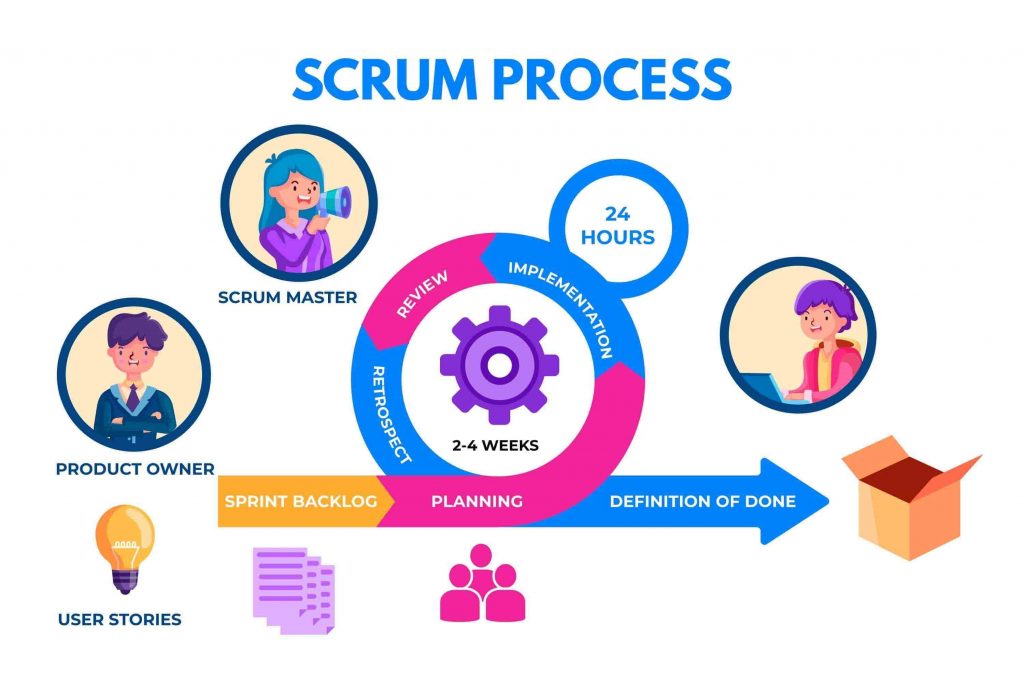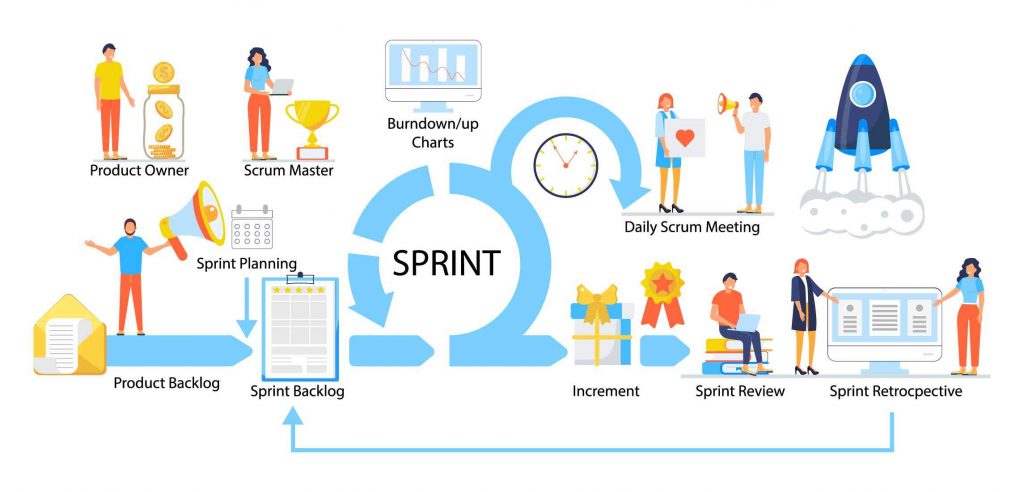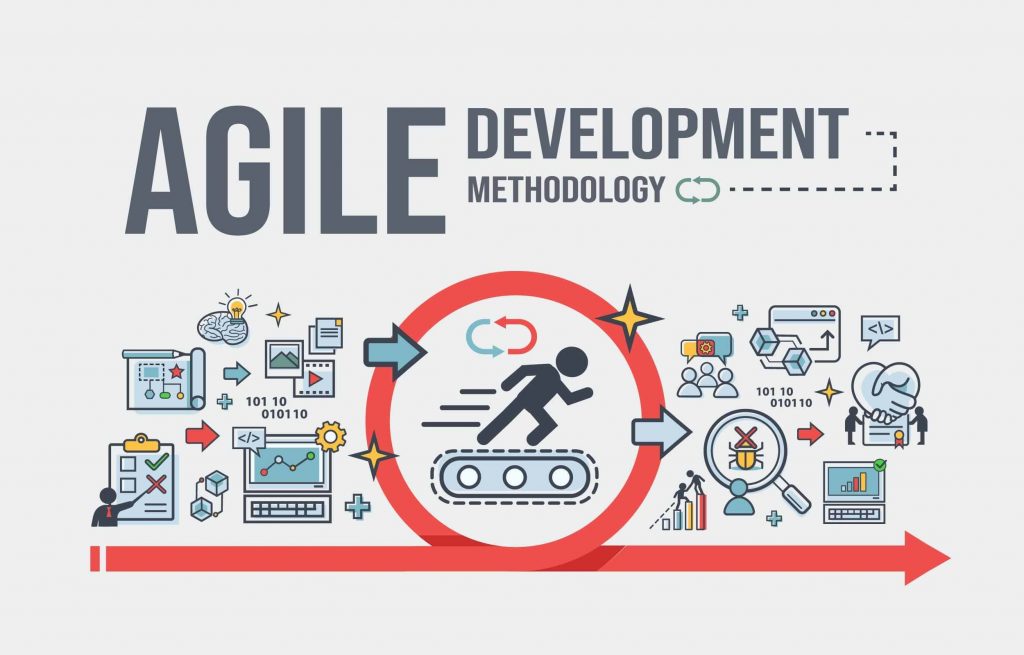As Stephen Hawking said “Intelligence is the ability to adapt to change’’. In this fast-paced and ever-evolving world of software development, the ability to swiftly adapt, respond to change, and deliver high-quality products is paramount. Traditional methods of software development often struggle to keep up with the dynamic nature of the industry, resulting in delayed projects, inflated budgets, and dissatisfied clients. However, a solution has revolutionized the way software is built – Agile Methodology.
Agile has emerged as a powerful framework that enables development teams to embrace change, foster collaboration, and prioritize customer satisfaction. It has gained immense popularity due to its ability to deliver incremental value, improve transparency, and enhance overall productivity. In the realm of software development, the choice of methodology can make a significant impact on the success of a project. With an array of options available, it becomes essential to evaluate each approach carefully and select the one that aligns best with the project’s goals, team dynamics, and client requirements.
How Agile Methodology Emerged?
The Agile movement gained momentum in 2001 when a group of seventeen prominent software development practitioners convened and drafted the Agile Manifesto. This gathering, known as the “Manifesto for Agile Software Development,” took place in Snowbird, Utah, and aimed to define a set of values and principles that would guide a more adaptive and customer-centric approach to software development.
The Manifesto for Agile Software Development consisted of four key values:
- Individuals and interactions over processes and tools: Emphasizes the importance of people working collaboratively and communicating effectively rather than relying solely on tools and processes.
- Working software over comprehensive documentation: Prioritizes delivering functional software that provides tangible value to the customer over excessive documentation that may not directly contribute to the end product.
- Customer collaboration over contract negotiation: Encourages active customer involvement throughout the development process, promoting frequent feedback and collaboration to ensure the software meets their evolving needs.
- Responding to change over following a plan: Recognizes the inevitability of change in software development projects and advocates for embracing change rather than adhering rigidly to a predetermined plan.
Why Should Choose Agile Methodologies For Software Development?

There are several compelling reasons to choose Agile methodologies for software development. Here are the key points:
Flexibility and Adaptability
Agile embraces change and allows for flexible project requirements. It enables teams to respond quickly to shifting priorities, market demands, and customer feedback, ensuring that the software remains relevant throughout the development process.
Customer Satisfaction
Agile methodologies prioritize customer collaboration and satisfaction. By involving customers throughout the development cycle and delivering incremental value, Agile ensures that the software meets their evolving needs and expectations, resulting in higher customer satisfaction.
Faster Time to Market
Agile promotes iterative development and frequent delivery of working software. This approach allows for faster time to market, as the software can be released in smaller, usable increments, providing immediate value to the end-users or stakeholders.
Continuous Improvement
Agile methodologies provide a culture of ongoing learning and development. Through regular retrospectives and feedback loops, teams can identify areas for enhancement, address challenges, and optimize their processes, leading to higher productivity and quality over time.
Enhanced Collaboration
Agile emphasizes cross-functional and self-organizing teams. By fostering collaboration and communication among team members, Agile methodologies create an environment where everyone is involved, engaged, and collectively responsible for the success of the project.
Transparency and Visibility
Transparency and visibility are encouraged by agile practices such as daily stand-up meetings and sprint reviews. This promotes successful communication and decision-making by ensuring that all stakeholders are aware of the project’s status, difficulties, and priorities.
Risk Mitigation
Agile methodologies enable early and frequent feedback from customers and stakeholders, reducing the risk of building software that does not meet their expectations. By continuously validating assumptions and incorporating feedback, Agile helps mitigate risks associated with misunderstood requirements or misaligned solutions.
Increased Product Quality
Agile’s iterative structure enables continuous testing and quality control throughout the whole development process. Agile approaches contribute to the early identification and resolution of issues, which results in greater software quality. They do this by incorporating testing and quality checkpoints at each stage.
Empowered Development Teams
Agile methodologies empower development teams to take ownership of their work and make decisions collectively. This autonomy and empowerment foster creativity, innovation, and job satisfaction among team members, leading to better outcomes and higher employee retention.
Measurable Progress
Agile methodologies provide clear metrics and performance indicators that enable teams and stakeholders to measure progress and track project success. These metrics, such as velocity and burn-down charts, provide valuable insights into the project’s status and help in making data-driven decisions.
In summary, choosing Agile methodologies for software development brings flexibility, customer satisfaction, faster time to market, continuous improvement, collaboration, transparency, risk mitigation, enhanced product quality, empowered teams, and measurable progress. These benefits make Agile an attractive and effective approach for modern software development projects.
Types Of Agile Methodologies
There are several types of Agile methodologies that have emerged over time. Here are some of the most widely recognized Agile methodologies. Each methodology has its own set of practices, roles, and ceremonies, allowing teams to choose the one that best suits their project requirements and organizational context. It’s important to note that Agile methodologies can also be customized and combined based on specific project needs, creating a hybrid approach that fits the unique circumstances of the software development endeavor.
Scrum
It is one of the most popular Agile methodologies which follows an iterative and incremental approach to software development. Scrum teams work in short timeframes called Sprints, typically lasting 1-4 weeks. The development process is divided into a series of time-boxed iterations, with specific roles such as Scrum Master and Product Owner and ceremonies such as daily stand-ups and sprint reviews to facilitate collaboration, transparency, and continuous improvement.

Kanban
Kanban focuses on visualizing and optimizing workflows. It emphasizes the efficient flow of work items through different stages. Kanban boards visually represent the work items and their status, helping teams to identify bottlenecks, optimize processes, and achieve a smooth and continuous flow of work. Kanban provides flexibility in terms of work prioritization and does not have predefined timeboxed iterations like Scrum.
Lean
Lean software development is an Agile methodology inspired by Lean manufacturing principles. Lean focuses on delivering value to customers quickly, reducing unnecessary work and delays. It emphasizes continuous improvement, respect for people, and maintaining a relentless focus on delivering value.
Extreme Programming (XP)
Extreme Programming is an Agile methodology that emphasizes software engineering practices to ensure high-quality development. XP places a strong emphasis on customer involvement, frequent feedback, and close collaboration within small, self-organizing teams. It promotes practices such as Test-Driven Development (TDD), pair programming, continuous integration, and regular refactoring to ensure code quality, maintainability, and responsiveness to changing requirements.
Feature-Driven Development (FDD)
Feature-Driven Development is an Agile methodology that focuses on the iterative and incremental delivery of software features. It emphasizes breaking down the development process into a set of feature-driven workflows. FDD incorporates practices such as domain object modeling, feature teams, regular progress reporting, and short iterations to ensure effective feature delivery.
Crystal
Crystal is an Agile methodology that recognizes the unique characteristics of different projects and tailors its practices accordingly. It offers various Crystal methodologies, such as Crystal Clear, Crystal Orange, and Crystal Yellow, which adapt to the project’s size, criticality, and team dynamics. Crystal methodologies emphasize frequent delivery, communication, and continuous reflection and adaptation.

Conclusion
Choosing an Agile methodology for software development is a strategic decision that can significantly enhance the success of your projects. Agile methodologies offer numerous advantages, making them the preferred choice for modern software development teams.
It fosters a culture of continuous improvement. Through regular retrospectives and feedback loops, teams identify areas for enhancement, address challenges, and optimize their processes. This focus on continuous learning and adaptation results in increased efficiency, productivity, and the delivery of high-quality software.
In summary, Agile methodologies offer a customer-centric, flexible, and iterative approach to software development. By embracing change, fostering collaboration, and continuously improving, Agile enables teams to deliver high-quality software that meets customer needs, reduces risks, and achieves project success. So, when it comes to software development, choosing Agile methodology is a wise and strategic choice that can propel your projects toward success.


 Schedule An Appointment
Schedule An Appointment